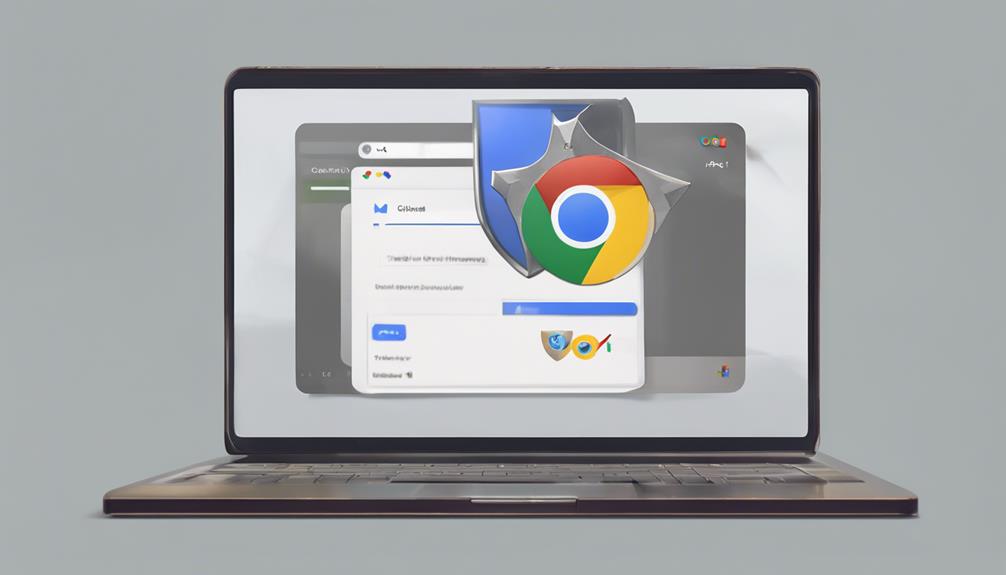Google Chat's security may be compromised as it lacks end-to-end encryption, making it vulnerable to hacking risks. The absence of this encryption leaves conversations open to unauthorized access, increasing the likelihood of data breaches, phishing, and malware attacks. While Google employs data encryption on its servers and offers two-step verification for added security, users should remain cautious. Exploring alternative messaging apps like Signal, Telegram, or WhatsApp, which offer end-to-end encryption and heightened security features, can be beneficial. Safeguarding against online threats demands vigilance and a proactive approach to protect one's data and privacy.
Key Takeaways
- Google Chat lacks end-to-end encryption in group chats, making it vulnerable to unauthorized access.
- Implement two-step verification for added security against hackers.
- Data encryption on Google servers protects user information from breaches.
- Exercise caution with shared data and avoid suspicious links to prevent hacking.
- Regularly update Google Chat for enhanced security measures.
Potential Vulnerabilities in Google Chat
Discussing the potential vulnerabilities in Google Chat reveals important security concerns that users should be aware of when utilizing the messaging platform.
While Google Chat lacks end-to-end encryption for permanent group chats, leaving conversations susceptible to unauthorized access, data encryption on Google servers provides a level of protection against hacking attempts. Users should exercise caution when sharing sensitive information on the platform.
Additionally, the collection of location data by Google Chat, although not for advertising purposes, necessitates a degree of vigilance to prevent location-based hacking incidents. Two-step verification support enhances security measures against potential hacker intrusions, offering an additional layer of protection.
Understanding Google Chat's privacy policies is essential, as the platform may be required to share data legally. By being mindful of these vulnerabilities and taking necessary precautions, users can navigate Google Chat with greater awareness and safeguard their information effectively.
Risks of Phishing and Malware

Phishing and malware pose significant risks to users of Google Chat. Hackers often utilize phishing tactics to deceive individuals into disclosing confidential information.
Additionally, the presence of malware on the platform can lead to unauthorized access to sensitive data.
Implementing strong security measures is essential to safeguard against these threats and protect user information.
Phishing Dangers in Chat
The prevalence of deceptive tactics in Google Chat presents significant risks associated with the unauthorized acquisition of personal information by malicious actors. Phishing dangers loom large within the platform, as hackers utilize deceptive messages to lure unsuspecting users into divulging sensitive information.
Unsolicited messages containing phishing attacks are a common method employed by cybercriminals to trick individuals into revealing personal data. These phishing tactics often aim to extract login credentials or financial details from users, posing a severe threat to their online security.
To safeguard against such risks, users must exercise caution when interacting on Google Chat, avoiding clicking on suspicious links or responding to unsolicited requests for sensitive information. The prominence of phishing dangers in Google Chat underscores the critical need for vigilance and awareness among users to mitigate the potential threats posed by malicious actors operating within the platform.
Malware Threats in Chat
Google Chat users are vulnerable to a range of malware threats, including phishing attacks that exploit security weaknesses within the platform. Hackers may use various tactics to target users, such as sending malicious links or attachments via chat messages.
These phishing attacks aim to deceive users into disclosing sensitive information, potentially leading to unauthorized access to accounts and data breaches.
It is important for users to exercise caution when interacting on Google Chat, avoiding clicking on suspicious links or downloading unknown files to mitigate the risks associated with malware threats.
Security Measures for Chat
To enhance the security of communication and protect users from potential malware threats, implementing strong security measures is essential when using chat platforms. Google Chat employs data encryption on its servers to safeguard against hacking attempts, while two-step verification adds an extra layer of protection.
However, it is important to note that Google Chat lacks end-to-end encryption for permanent group chats, which could pose a risk to sensitive information shared within those chats. Additionally, the platform may share user data in response to legal orders, potentially impacting user privacy.
To combat malware and phishing threats, Google Chat has mechanisms in place for the detection and blocking of such malicious activities. These measures collectively contribute to enhancing the overall security of Google Chat and mitigating risks associated with cyber threats.
Lack of End-to-End Encryption

Google Chat's lack of end-to-end encryption in permanent group chats raises significant concerns regarding data security. The absence of this encryption leaves sensitive information vulnerable to potential breaches, as data can be accessed by Google and potentially by hackers.
Users should exercise caution when sharing confidential information on Google Chat due to these privacy concerns.
Encryption Vulnerability
The absence of end-to-end encryption in Google Chat exposes user messages to potential security vulnerabilities and unauthorized access. This encryption vulnerability means that Google Chat messages are not fully protected from being accessed by unauthorized parties, including hackers or even Google itself.
Without end-to-end encryption, the privacy and security of sensitive communications shared on Google Chat are at risk. Users should be cautious when exchanging confidential information through this platform due to the potential for unauthorized access to their messages.
To address these concerns, it is advisable for users to implement additional security measures such as two-step verification. By incorporating such risk mitigation strategies, users can better safeguard their communications and reduce the likelihood of unauthorized access to their Google Chat messages.
Data Privacy Concerns
Given the absence of end-to-end encryption in Google Chat, data privacy concerns arise regarding the vulnerability of user information to unauthorized access and interception by malicious actors.
The lack of end-to-end encryption in permanent group chats within Google Chat poses a significant risk of data interception during transmission, potentially exposing sensitive information to hacking risks. This security vulnerability raises alarming privacy concerns as confidential information shared on the platform may be accessed without authorization.
Hackers could exploit the absence of end-to-end encryption to illicitly gain access to conversations and sensitive data stored on Google Chat, highlighting the importance of users being cautious about the information they share. Without the protection of end-to-end encryption, users must be mindful of the potential for unauthorized access and data breaches, emphasizing the need for enhanced security measures to safeguard the privacy of user data on Google Chat.
Protecting User Data and Privacy

Enhancing user data security and privacy is a top priority for Google Chat, achieved through various protective measures. Google Chat employs robust security features such as data encryption on Google servers to safeguard user information from unauthorized access.
Additionally, the implementation of two-step verification adds an extra layer of protection against potential hacking attempts, ensuring a secure messaging environment for users. However, it is important to note that the lack of end-to-end encryption for permanent group chats may pose a security risk, highlighting the importance of remaining vigilant while using the platform.
Furthermore, Google Chat respects user privacy by collecting location data but refrains from utilizing it for advertising purposes, demonstrating a commitment to safeguarding user information. In cases where legal orders may necessitate data sharing, Google Chat prioritizes user security and privacy, maintaining a delicate balance between compliance with regulations and protection of user data.
Enhancing G Suite Security

Enhancing G Suite security involves configuring data loss prevention controls to prevent breaches and implementing best practices to safeguard sensitive information.
Additionally, encrypting Google Chat messages using Transport Layer Security (TLS) provides an extra layer of protection against unauthorized access.
However, the lack of end-to-end encryption for message storage in Google Chat raises concerns about potential data exposure risks.
G Suite Security Measures
G Suite's security measures encompass a range of features such as two-step verification and encryption to safeguard against potential hacking threats. By utilizing these security features, G Suite users can add an additional layer of protection to their accounts and data.
Additionally, configuring data loss prevention controls within G Suite can help prevent unauthorized access and enhance overall security. Implementing best practices for G Suite security is vital in mitigating risks of data breaches and hacking incidents.
Monitoring Google Chat for compliance with regulations such as FERPA and HIPAA is essential to prevent unauthorized access by hackers. While Google Chat lacks end-to-end encryption for message storage, this security risk can be addressed through proper monitoring and controls.
It is imperative for G Suite users to stay vigilant and proactive in implementing security measures to protect their sensitive information from potential threats.
Google Chat Encryption
To fortify G Suite security measures, Google Chat employs encryption protocols for both data in transit and at rest on Google servers. This encryption guarantees that user data is safe from unauthorized access, enhancing the overall security of the messaging platform.
While Google Chat offers robust encryption, the lack of end-to-end encryption for permanent group chats poses a potential security risk, underscoring the importance of users being cautious with sensitive information.
Additionally, two-step verification supported by Google Chat adds an extra layer of security, making it harder for hackers to gain access to user accounts.
Monitoring Compliance With Regulations

Monitoring compliance with regulations in Google Chat is essential for safeguarding sensitive information and maintaining adherence to laws like FERPA and HIPAA. By utilizing compliance monitoring tools, organizations can detect unauthorized access or sharing of protected data, thereby preventing violations of privacy laws and regulations. These solutions offer visibility into chat content, enabling proactive measures to uphold compliance. Additionally, monitoring student safety signals on Google Chat helps identify and address potential risks or inappropriate behavior, enhancing overall security measures.
To effectively integrate monitoring into cybersecurity strategies and uphold adherence to industry regulations, organizations need to employ robust monitoring systems. The table below outlines key aspects related to monitoring compliance with regulations in Google Chat:
| Aspect | Description | Importance |
|---|---|---|
| Detection of Unauthorized Access | Monitoring tools can identify and prevent unauthorized individuals from accessing sensitive data. | High |
| Compliance with Privacy Laws | Ensuring that chat content complies with privacy laws and regulations to protect user data. | Medium |
| Student Safety Monitoring | Monitoring signals to detect potential risks or inappropriate behavior for student safety. | High |
| Integration with Cybersecurity Strategies | Linking monitoring tools with cybersecurity measures to enhance overall data protection. | High |
Considering Alternative Messaging Apps

Exploring alternative messaging apps can provide additional options for secure communication beyond Google Chat, with platforms like Signal, Telegram, WhatsApp, Discord, Microsoft Teams, and Slack offering various features to cater to specific communication needs. These messaging platforms prioritize security through end-to-end encryption, ensuring that only the sender and recipient can access the contents of their messages.
Here are some key points to evaluate when assessing alternative messaging apps:
- Signal and Telegram offer robust end-to-end encryption for heightened security.
- WhatsApp secures private conversations with end-to-end encryption.
- Discord provides secure communication channels tailored for gaming communities.
Implementing Security Best Practices

Implementing security best practices is vital for safeguarding your Google Chat conversations and protecting your sensitive information from potential hacking threats. To enhance security, it is essential to implement two-step verification on your Google account, making it more challenging for hackers to gain unauthorized access.
Additionally, regularly updating your devices and applications can help mitigate vulnerabilities that hackers could exploit on Google Chat. Exercise caution when sharing personal information and avoid clicking on suspicious links from unknown contacts to prevent hacking risks.
It's important to note that Google Chat lacks end-to-end encryption for permanent group chats, leaving them vulnerable to hacking attempts. While two-step verification is supported by Google Chat, enhancing security measures, the absence of end-to-end encryption in group chats highlights a potential area of concern for users.
Evaluating Encryption Features

Evaluating the encryption features of Google Chat reveals a mix of protective measures and potential vulnerabilities, shedding light on the platform's security capabilities. While Google Chat encrypts data both in transit and at rest on its servers, the absence of end-to-end encryption in permanent group chats raises concerns about data protection.
The collection of location data by Google Chat, albeit not for advertising purposes, underscores the importance of user privacy and the need for stringent security measures. Additionally, the platform's compliance with legal orders may involve sharing data, emphasizing the delicate balance between user privacy and legal obligations.
- Encryption safeguards data in transit and at rest, enhancing security measures against hacking attempts.
- Lack of end-to-end encryption in group chats may leave sensitive information vulnerable to interception.
- Two-step verification provides an additional layer of protection, fortifying user privacy against potential breaches.
Safeguarding Against Online Scams

How can users enhance their security measures on Google Chat to protect against the rising threat of online scams?
Users should exercise caution when using Google Chat to safeguard against scammers who target individuals with phishing and malware attacks. While Google Chat employs data encryption on their servers to protect against hacking, users can further enhance their security by enabling two-step verification for an added layer of protection. However, it's essential to note that Google Chat lacks end-to-end encryption for permanent group chats, which could pose security risks.
In light of scammers exploiting vulnerabilities, users must prioritize online safety by being vigilant and proactive in identifying potential threats. By staying informed about common tactics used by scammers and being mindful of the information shared on Google Chat, users can mitigate the risk of falling victim to online scams. Additionally, maintaining user privacy is crucial, as Google Chat may disclose data if required by a legal order.
Frequently Asked Questions
Is Google Chat Safe to Use With Strangers?
When considering safety on Google Chat for interactions with strangers, examining the platform's security measures, privacy settings, and user guidelines becomes crucial. Prioritizing caution and verifying contact identities play pivotal roles in ensuring a secure experience.
Can Someone Steal Your Information on Google Chat?
Data security on Google Chat is a crucial concern. While encryption safeguards against hacking attempts, the lack of end-to-end encryption in some chat scenarios poses risks. Employing two-step verification and managing privacy settings can enhance protection against potential data breaches.
How Secure Is Google Chat?
Google Chat employs robust encryption measures, malware detection, and phishing prevention features to enhance security. While lacking end-to-end encryption in group chats, two-step verification adds an additional layer of protection, making it a secure communication platform.
Why Do People Want to Talk on Google Chat?
People prefer Google Chat for its seamless messaging, collaboration, and integration with Google Workspace apps. The platform's user-friendly interface, customizable settings, and efficient message search capabilities enhance productivity and communication within organizations.
Conclusion
To sum up, while Google Chat may have vulnerabilities that make it susceptible to hackers, implementing security best practices and evaluating encryption features can help safeguard user data and privacy.
It is important for users to be aware of the risks of phishing and malware, as well as the significance of G Suite security.
By taking proactive measures to enhance security and considering alternative messaging apps, individuals can better protect themselves from online threats.
Remember, vigilance is key in the digital age.









